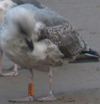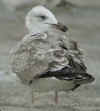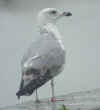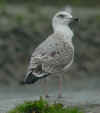 Yellow-legged
Gull - Larus michahellis
Yellow-legged
Gull - Larus michahellis
(last update: October 08 2013)
Coordinators:
Delfín González
Gabriel Martín
Antonio Gutierrez
Amir Ben Dov
Mars Muusse
Larus michahellis - 2CY October
This website deals with the Yellow-legged Gull taxon michahellis, which is a common migrant from July to December in NW Europe. After extensive expansion of the breeding population during the last three decades, it nowadays can be found breeding in Belgium, the Netherlands and Britain in mixed couples with both Herring Gull (argenteus) and Lesser Black-backed Gull (graellsii). There are subtle differences between the populations from the Mediterranean, Atlantic coast of Portugal and Morocco and from the islands in the Atlantic. Most pronounced differences can be found in the taxon atlantis, now regarded as full species by some authors and birds along the Atlantic coast of the Iberian peninsular: lusitanius. Both atlantis and lusitanius are treated in their own sections on this website.
General description
By early October, the primary moult is in its
last stage, with only the outermost primary P10 still not completely fully
grown in some birds. But many birds show fully grown P10 and therefore
have finished the complete moult, which started in April.
As can be seen in the August and September sections, the partial autumn moult in
2CY michahellis is in progress, and this
partial autumn moult will finish at the end of the month, based on surveys
in Etaples and
Boulogne-sur-Mer,
NW France.
Most 2CY birds include the inner greater coverts,
central and outer median coverts and most lower lesser
coverts in the partial moult. The upper tertials and more rarely some lesser
coverts may be replaced again as well.
Moult stage and pace of remiges and rectrices
The table below presents three primary moult scores for early and late October at Etaples, Calais region, NW France. By late October, the primary moult is completed in almost all 2CY michahellis (and by finishing this primary moult, they finish the complete moult of the summer months).
These michahellis figures can be compared to 2CY argenteus. The differences in average PMS between the two species are limited but apparent early in the month. 2CY Larus argentatus l.s. from the Netherlands are about 0.9 points behind, compared to 2CY michahellis from NW France. Note however that from September onwards, Scandinavian argentatus join the local population of argenteus, resulting in an obvious increase in the range of individual primary scores, as can be read from the increase in standard deviations from the end of the month onwards.
All 2CY michahellis have finished moult in the secondaries and rectrices by the second week of September. By the end of September, moult in the rectrices may be seen again in just less than 20% of 2CY michahellis. Birds grow in plain white tail-feathers or white feathers with limited black vermiculation in the partial moult. Table three shows an overview of rectrices moult scores of 22 birds from mid-September. Since the tail-feathers are moulted centrifugally, the replaced tail-feathers are normally the inner rectrices R1 and R2.
Timing and strategy of partial moult
In the complete moult during the summer, 2CY michahellis moult all the
scapulars, wing-coverts, tertials and rectrices. In the July and August sections the progress of this complete moult is described.
By August, the
complete moult in the wing-coverts is finished with replacement of the last
central greater coverts and finally the feathers in the carpal edge (outer lesser
coverts). As those last lesser coverts are replaced for second
generation feathers, the partial autumn moult starts in 2CY michahellis,
starting again
with the upper tertials and outer median coverts. The
box below enlarges upon the partial moult in autumn in 2CY michahellis.
By September, all 2CY michahellis are in active partial moult
again.
In most individuals, the moult strategy follows a common strategy, although it may vary between individuals. 2CY michahellis start the partial moult with shedding the outermost median coverts, followed by the upper tertials. This moult stage can be found commonly in late August (see e.g. image 05 in the August section) but may be found in late September birds as well (image 4733). Most extensive moult takes place in the median and lower lesser coverts. Moult in the greater coverts is often confined to the inner feathers and moult in the tertials is often confined to the upper three feathers. 2CY michahellis hardly replace lesser coverts, and if they do, there is no distinguishable sequence.
The October moult stage: most 2CY birds have the innermost greater coverts, most of the median and lower lesser coverts replaced. The upper tertails are included in this partial moult as well. The final extend of the partial moult is reached by late-October, when birds have the moult gaps closed, as can be seen in the images.
The pattern of the new feathers in the wing-coverts vary from plain adult-like grey feathers
to feathers hardly distinguishable from the old second generation
feathers. Those feathers show a anchor pattern or barred pattern (dark
brown to blackish) with a pronounced dark broad shaft-streak on a warm
brown base (but the brown tone of these feathers will bleach to almost
white with time). Some birds show intermediate patterns: a plain grey
base of the feather with a brownish upper half, an anchor pattern and a
clear white fringe.
Some birds may look very advanced, similar to 3CY birds,
after completion of the partial moult, with plain grey feathers in all the
scapulars, the upper four tertials, the inner 10 greater coverts, all
median and lower lesser coverts and all visible lesser coverts. In
general: grey upper-parts and white under-parts in these birds.
It's hard to label the feathers to exact generation. As can be seen in the 1CY michahellis October section, the post-juvenile moult in michahellis can be very extensive. Most michahellis moult inner wing-coverts to second generation in 1CY October. They replace these wing-coverts again in the complete moult in July-August. Then again, inner wing-coverts are replaced by the partial moult in 2CY michahellis in September, but not necessarily the same wing-coverts as in the post-juvenile moult.
Moult stage and pace of scapulars
By October, new scapulars may grow in, either fourth or fifth generation feathers. Nevertheless, the pattern may be still not completely adult-like. Due to the considerable moult in the scapulars in 1CY birds in August, in 2CY birds in April-May, in July and again in September, we exclude the scapulars from further analysis.
Movements
The majority of michahellis in NW France arrive from SW origins, the colonies from Marseille and the Mediterranean coast, Italy, Switzerland and the German Rhine colony. By September, the majority has arrived in NW France and in the Netherlands, largest groups can be found in this month. From mid-October, numbers drop again, as birds migrate south along the Atlantic coast.
Tables
| 2CY michahellis scores of new second generation primaries: Etaples & Le Portel, NW France. | |||
| new prims | Oct 04 2002 | Oct 05 2002 | Oct 25 2002 |
| p9 | 8 | 3 | 0 |
| p10 | 16 | 18 | 10 |
| n: | 24 | 21 | 10 |
| m: | 9.7 | 9.9 | 10.0 |
| SD: | 0.48 | 0.36 | 0.00 |
Notes: |
|||
| 2CY argenteus scores of new second generation primaries: October 2000 at Scheveningen, the Netherlands. | ||||||
| new prims | 05 Oct | 07 Oct | 12 Oct | 14 Oct | 21 Oct | 26 Oct |
| p7 | 2 | 3 | 1 | 0 | 0 | 0 |
| p8 | 12 | 32 | 12 | 11 | 4 | 0 |
| p9 | 14 | 43 | 23 | 21 | 5 | 4 |
| p10 | 6 | 45 | 25 | 35 | 28 | 38 |
| n: | 34 | 123 | 61 | 67 | 37 | 42 |
| m: | 8.7 | 9.1 | 9.2 | 9.4 | 9.6 | 9.9 |
| SD: | 0.84 | 0.85 | 0.81 | 0.75 | 0.68 | 0.30 |
Notes: |
||||||
 Yellow-legged
Gull michahellis 2CY 924D October 03 2002, Le Portel,
France.
Yellow-legged
Gull michahellis 2CY 924D October 03 2002, Le Portel,
France. Yellow-legged Gull michahellis 2CY ISCD October 05 2005, Chablais de Cudrefin, Switzerland. Picture: Stephane Aubry.
Yellow-legged Gull michahellis 2CY ISCD October 05 2005, Chablais de Cudrefin, Switzerland. Picture: Stephane Aubry. Yellow-legged
Gull michahellis 2CY CF 4024 October 24 2008, Etaples, France. Picture: Theo Muusse & Ies Meulmeester.
Yellow-legged
Gull michahellis 2CY CF 4024 October 24 2008, Etaples, France. Picture: Theo Muusse & Ies Meulmeester. Yellow-legged
Gull michahellis 2CY 84Y October 09 2009, IJmuiden, the Netherlands.
Yellow-legged
Gull michahellis 2CY 84Y October 09 2009, IJmuiden, the Netherlands. Yellow-legged Gull michahellis 2CY-3CY S3E4 October 2009-2010, IJmuiden, the Netherlands.
Yellow-legged Gull michahellis 2CY-3CY S3E4 October 2009-2010, IJmuiden, the Netherlands. Yellow-legged Gull michahellis 2CY S77H October 21 2012, Tučepi, Makarska, Croatia (43.15 N 17.03 E).
Picture: Milena Beus.
Yellow-legged Gull michahellis 2CY S77H October 21 2012, Tučepi, Makarska, Croatia (43.15 N 17.03 E).
Picture: Milena Beus. Yellow-legged Gull lusitanius 2CY 0BK.R October 27 2013, Meirás, Spain. Picture: Antonio Gutierrez.
Yellow-legged Gull lusitanius 2CY 0BK.R October 27 2013, Meirás, Spain. Picture: Antonio Gutierrez. Yellow-legged Gull lusitanius 2CY 409M October 27 2013, Pantín, Spain. Picture: Antonio Gutierrez.
Yellow-legged Gull lusitanius 2CY 409M October 27 2013, Pantín, Spain. Picture: Antonio Gutierrez. Yellow-legged Gull michahellis 2CY HES M030444 October 31 2013, Westkapelle, the Netherlands.
Yellow-legged Gull michahellis 2CY HES M030444 October 31 2013, Westkapelle, the Netherlands. Yellow-legged
Gull michahellis 2CY, October 14 2009, Westkapelle, the Netherlands. Typical 2CY YLG for October.
Yellow-legged
Gull michahellis 2CY, October 14 2009, Westkapelle, the Netherlands. Typical 2CY YLG for October. Yellow-legged
Gull michahellis 2CY, October 01 2001, Le Portel,
France.
Yellow-legged
Gull michahellis 2CY, October 01 2001, Le Portel,
France. Yellow-legged
Gull michahellis 2CY, October 01 2001, Le Portel,
France.
Yellow-legged
Gull michahellis 2CY, October 01 2001, Le Portel,
France. Yellow-legged
Gull michahellis 2CY, October 01 2001, Le Portel,
France.
Yellow-legged
Gull michahellis 2CY, October 01 2001, Le Portel,
France. Yellow-legged
Gull michahellis 2CY, October 03 2002, Etaples,
France.
A very advanced looking individual.
Yellow-legged
Gull michahellis 2CY, October 03 2002, Etaples,
France.
A very advanced looking individual. Yellow-legged
Gull michahellis 2CY,October 14 2001, Westkapelle,
the Netherlands. A typical 2CY YLG for October.
Yellow-legged
Gull michahellis 2CY,October 14 2001, Westkapelle,
the Netherlands. A typical 2CY YLG for October.  Yellow-legged
Gull michahellis 2CY, October 04 2002, Etaples,
France.
Yellow-legged
Gull michahellis 2CY, October 04 2002, Etaples,
France. Yellow-legged
Gull michahellis 2CY, October 05 2001, Brouwersdam,
the Netherlands.
Yellow-legged
Gull michahellis 2CY, October 05 2001, Brouwersdam,
the Netherlands. Yellow-legged
Gull michahellis 2CY, October 13 2001, Westkapelle,
the Netherlands. Typical michahellis for October.
Yellow-legged
Gull michahellis 2CY, October 13 2001, Westkapelle,
the Netherlands. Typical michahellis for October. Yellow-legged
Gull michahellis 2CY, October 22 2001, Westkapelle,
the Netherlands. With rather dense barring
on the outer greater coverts.
Yellow-legged
Gull michahellis 2CY, October 22 2001, Westkapelle,
the Netherlands. With rather dense barring
on the outer greater coverts. Yellow-legged
Gull michahellis 2CY, October 22 2001, Westkapelle,
the Netherlands.
Yellow-legged
Gull michahellis 2CY, October 22 2001, Westkapelle,
the Netherlands.  Yellow-legged
Gull michahellis 2CY, October 22 2001, Westkapelle,
the Netherlands.
Yellow-legged
Gull michahellis 2CY, October 22 2001, Westkapelle,
the Netherlands.  Yellow-legged
Gull michahellis 2CY, October 22 2001, Westkapelle,
the Netherlands.
Yellow-legged
Gull michahellis 2CY, October 22 2001, Westkapelle,
the Netherlands.
